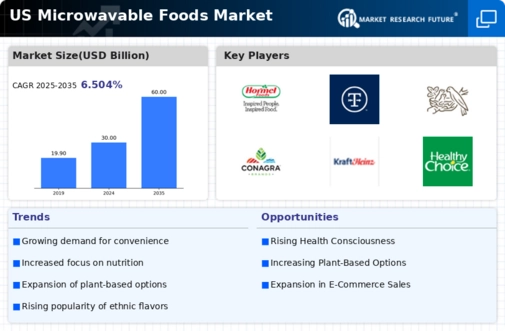The US Microwavable Foods Market is characterized by a fast-paced competitive landscape driven by evolving consumer preferences, convenience, and lifestyles that prioritize ready-to-eat meal options. As the demand for quick meal solutions increases, several key players are vying for market share through innovation, product diversification, and strategic marketing. The market includes a mix of established firms and emerging brands, each aiming to capture the attention of busy consumers through flavorful and nutritionally balanced offerings. Companies invest heavily in research and development to optimize product appeal, including healthier options and unique flavors, catering to an increasingly diverse consumer base.
The competitive dynamics are also influenced by pricing strategies, distribution channels, and brand loyalty, as brands seek to establish themselves as leaders in this rapidly growing segment.Hormel Foods has carved out a significant position within the US Microwavable Foods Market by leveraging its strong portfolio of well-known brands and an extensive distribution network. The company’s focus on innovation has led to the introduction of a variety of products that cater to the needs of health-conscious consumers while maintaining convenience.
Known for its commitment to quality, Hormel Foods has adopted sustainable sourcing practices and developed an array of microwavable solutions that emphasize both taste and nutrition. Their well-established market presence is bolstered by effective advertising and a loyal customer base, which enables Hormel Foods to compete effectively against other players in the market.
The company continuously studies consumer trends and preferences to enhance its product offerings, ensuring that it remains a key competitor in the US microwavable foods sector.Tyson Foods also enjoys a strong foothold in the US Microwavable Foods Market, owing to its diversified product range that includes frozen meals and microwave-ready protein options. The company focuses on providing high-quality protein products as well as meal solutions that appeal to busy families and health-conscious individuals alike. Tyson Foods has made strategic moves through acquisitions and partnerships to expand its market presence and product lines.
The company emphasizes innovation, introducing new products that reflect dietary trends, such as high-protein and lower-calorie options. Its strong distribution capabilities ensure wide availability across various retail channels, enhancing accessibility for consumers. Tyson Foods' commitment to quality and an understanding of consumer preferences position it favorably within the competitive landscape of the US microwavable foods market, allowing the company to adapt and respond effectively to changing market dynamics.















